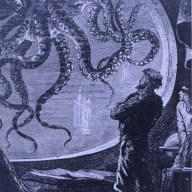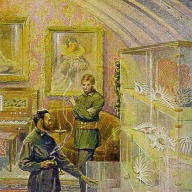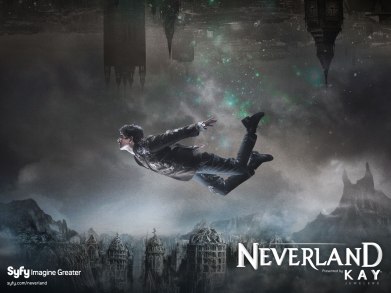Glub glub in a Steampunk Sub

I have started work on the sequel to Riftmaker, and I am planning to include a super cool Steampunk submarine. I have been collecting images for inspiration so I thought I’d share the fruits of my labors with you. When possible, I have credited the artist but most of these images came via Pinterest so if you see something miss-credited or you know who was the brains behind a certain sub please let me know.
Steampunk Book Review: 20,000 Leagues Under the Sea
 Even if people aren’t a fan of science fiction, chances are they have heard of this book or seen the 1954 Disney movie version. If you read my review of Around the World in 80 Days, you know I am only lukewarm on Jules Verne’s writing style, but I’ve read a few different Steampunk books that use Captain Nemo as a character, so I wanted to go back to the original source to learn a bit more.
Even if people aren’t a fan of science fiction, chances are they have heard of this book or seen the 1954 Disney movie version. If you read my review of Around the World in 80 Days, you know I am only lukewarm on Jules Verne’s writing style, but I’ve read a few different Steampunk books that use Captain Nemo as a character, so I wanted to go back to the original source to learn a bit more.
It all begins with the mysterious disappearances of various vessels in 1866. Many believe a giant sea creature is behind the attacks, and the narrator, a French marine biologist named Pierre Aronnax, is enlisted to aid in the search while visiting New York. He departs from the United States along with his faithful manservant, Conseil, and together they join a team of explorers including a Canadian harpooner named Ned Land. Shortly after setting out, the intrepid team encounters the creature, only to find it is in fact an incredibly advance submarine captained by one of the most famous figures in all of Steampunk literature, Captain Nemo. The rest of the story details the journey of Aronnax, Conseil and Land as they criss-cross the globe as Nemo’s prisoners.
20,000 Leagues Under the Sea was incredibly well-researched. I used to work at an aquarium, so I probably was able to get a bit more out of it than the average reader, because the narrator, Aronnax, goes into exhaustive detail about the different marine animals he encounters while traveling the seven seas with Nemo. I would like to read it again some day, but this time I would make sure to find an illustrated version. When the story was originally published as a serial in Magasin d’Éducation et de Récréation from 1869-1870 it did not include any illustrations, but since it was compiled as a novel a few years later there have been several illustrated and even a graphic novel version of the tale.
But, this meticulous detail can also be a drag. The Mister and I read this one out loud as we often do with the books I review, and even though I have my science background and he is a Roman historian, we both stumbled over the multitude of Latin names. Though of course it makes sense to use the proper scientific names of species, both for clarity and because the narrator is a marine biologist, it can make the actual reading a bit tedious. We were about halfway through when my brain was just begging for a giant squid to attack. This bit of action comes very late in the book, and gets a lot more attention in movie adaptations than Verne gave it in the text.
Unlike Around the World in 80 Days, where the indefatigable Passepartout can offer a respite from the monotony of travel, there is no comedic relief in 20,000 Leagues. Nemo is an interesting and enigmatic character to be sure, but I think overall it makes for pretty dry reading. The science in this book is sound, so it holds up to time better than Journey to the Center of the Earth, but for me it wasn’t really entertaining enough for the slog through over 300 pages.
League of Extraordinary Gentlemen (2003) Breaks the Mold When it Comes to Movies Based on Books…

I honestly can’t remember any other time this has happened to me, but I think the movie is actually BETTER than the books it is based on! It takes the best elements of Volume 1 a smidge from Volume 2, but the plot is totally different from either in the end.
Allan Quartermain (Sean Connery) if the first recruit after armed men attack him in Africa. Though he is on shaky ground with queen and country he answers the call and finds himself in London face-to-face with a mysterious agent for the crown known only as “M” (Richard Roxburgh). He meets the other members so far assembled like Captain Nemo (Naseeruddin Shah), Mina Harker (aka Mina Murray, played by Peta Wilson) and Rodney Skinner (Tony Curran), who is this version of the League’s Invisible Man.
 They set off together to bring a reluctant Dorian Gray (Stuart Townsend) into the fold, where they are ambushed by The Phantom and his men. Luckily, Tom Sawyer (Shane West) of the CIA had infiltrated the henchmen and saves our heroes with his sharp shooting. After Quartermain and Sawyer capture Mr. Hyde/Dr. Jekyll (Jason Flemyng) in Paris the League is complete, and M sends them to Venice to save a group diplomats at a peace summit. The plot thickens when they find out there is a traitor in their midst, and the string of explosions bringing Venice down around them is only the beginning.
They set off together to bring a reluctant Dorian Gray (Stuart Townsend) into the fold, where they are ambushed by The Phantom and his men. Luckily, Tom Sawyer (Shane West) of the CIA had infiltrated the henchmen and saves our heroes with his sharp shooting. After Quartermain and Sawyer capture Mr. Hyde/Dr. Jekyll (Jason Flemyng) in Paris the League is complete, and M sends them to Venice to save a group diplomats at a peace summit. The plot thickens when they find out there is a traitor in their midst, and the string of explosions bringing Venice down around them is only the beginning.
This movie is really fun and I love watching it. The effects are special and the action is well-paced. It doesn’t break a whole lot of new ground and besides Nemo’s car it doesn’t really have as many gadgets as one might like to see in their Steampunk, but I love seeing a world where all of these literary heroes (and anti-heroes) get to team up.
 There are a few very important differences from the books to the film, some of which were brilliant and some were disappointing. First, Dr. Jekyll gets to play a much larger role in the movie than in the books, and with the addition of Gray and Sawyer the League feels bigger and more complete. Mina is given both a larger and smaller role at the same time, because in the books she is the clear leader of the League but in the movie she is not only a scientist but force to be reckoned with on the battlefield. I think she was subsumed as leader mostly because of the desire for a Sean Connery type to play the part of Quartermain. The League didn’t have quite enough “flash” to it for the big screen, so they needed a more dynamic male lead to be opposite Mina (especially if they had hopes to pursue a romantic storyline in a sequel). There aren’t that many silver fox action heroes out there, so I think they took advantage of having the right actor for that kind of part rather than keeping to the book’s portrayal of Allan as a skinny, wrinkly drug addict.
There are a few very important differences from the books to the film, some of which were brilliant and some were disappointing. First, Dr. Jekyll gets to play a much larger role in the movie than in the books, and with the addition of Gray and Sawyer the League feels bigger and more complete. Mina is given both a larger and smaller role at the same time, because in the books she is the clear leader of the League but in the movie she is not only a scientist but force to be reckoned with on the battlefield. I think she was subsumed as leader mostly because of the desire for a Sean Connery type to play the part of Quartermain. The League didn’t have quite enough “flash” to it for the big screen, so they needed a more dynamic male lead to be opposite Mina (especially if they had hopes to pursue a romantic storyline in a sequel). There aren’t that many silver fox action heroes out there, so I think they took advantage of having the right actor for that kind of part rather than keeping to the book’s portrayal of Allan as a skinny, wrinkly drug addict.
All in all, I would say the changes that they made helped the movie to feel full and rich in a short amount of time when they didn’t have two books to work with.
Steampunk Sourcebook: Captain Nemo

The enigmatic Captain Nemo made his first appearance in Jules Verne’s science fiction classic, 20,000 Leagues Under the Sea (1870), which takes place in the late 1860s. Little is revealed about the mysterious figure besides his hunger for scientific knowledge and his rejection of imperialism and by extension, most of the world above the ocean. He and his dedicated crew exist “below the law” by rarely stepping foot on dry land and aiding those oppressed by imperialism. In the second novel featuring Nemo, The Mysterious Island (1874), he tells a group of castaways that he is the son of a raja named Prince Dakkar and that he lost his family in the First Indian War for Independence against the British (1857). After the death of his loved ones he goes into hiding and embarks on secret scientific research, culminating in an electric submarine called the Nautilus.
Fun Facts and Context:
۞ Nemo means “Nobody” in Latin
۞”20,000 Leagues under the sea” is often interpreted as the vertical distance down into the depth of the ocean, but it is a slight mistranslation of the french title “Vingt mille lieues sous les mers” where mers (meanings seas, plural) was translated as “sea.” It is meant to indicate the horizontal distance traveled under the water, not the depth of the water. 20,000 leagues is 6 times bigger than the diameter of the planet (each league is 4 kilometers).
۞ In the original manuscript, Nemo was a Polish noble whose family was killed in the January Uprising (1863-1865) by Russian oppressors. Fearing a blow to sales (as well as insulting France’s ally), Verne’s editor asked him to change the character and keep the details shadowy.
۞ Though he is an Indian prince in the final iteration of the novel, Nemo spent most of his formative years in Europe so he speaks with a British accent (he admits to speaking French, Latin and Gerrman as well).
۞ And though he hates the imperialist nature of European nations, the Nautilus is full of treasures from around Europe including an organ which Nemo plays masterfully. There is also a substantial library on board to feed his scientific pursuits.
۞ Nemo has a brief appearance in one more of Verne’s works, a play called Journey Through the Impossible. The play was not published until 1981 after a handwritten copy was discovered in 1978. The first English translation was completed in 2003.
۞ There was a real submarine called the Nautilus, which was designed by an American inventor living in France named Richard Fulton. It was developed in the late 1700s and was powered by a hand crank.
Captain Nemo has appeared in various adaptations of Verne’s novels, but few of these belong in the Steampunk canon. For instance, the 1954 film adaptation is heavily influenced by the style and politics of the era, and some important details are changed (for instance, the Nautilus runs on nuclear power rather than electricity). You can find a full list of Captain Nemo’s appearances here, but for the sake of this post I am focusing on the versions of Nemo that fit firmly into Steampunk.
For instance, Alan Moore’s graphic novels (and the film adaptation) featuring The League of Extraordinary Gentlemen. In this series, Nemo is much more callous, even bloodthirsty, than the original character. Verne’s Nemo saved whales, Moore’s Nemo mows down people with machine guns (Volume 1).
Captain Nemo also appears in The Other Log of Phileas Fogg, a 1973 novel by Philip Jose Farmer. If you haven’t guessed it, this is a crossover novel that takes place in the world of Around the World in 80 Days but incorporates (or rather co-opts) characters from other novels like Sir Arthur Conan Doyle’s Sherlock Holmes series. In Farmer’s account, Captain Nemo is better known in some circles at Professor Moriarty.
Kevin J. Anderson rewrites Captain Nemo’s history (and brings a childhood spent with Jules Verne into the mix) in his novel, Captain Nemo: The Fantastic History of a Dark Genius (2002).
Check out my gallery below for various versions of this Victorian antihero and other steamy sea captains.





































































































































